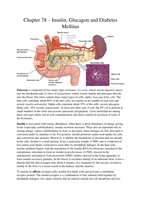Chapter 78 – Insulin, Glucagon and Diabetes
Mellitus
Pancreas is composed of two major types of tissues: (1) acini, which secrete digestive juices
into the duodenum and (2) islets of Langerhans, which secrete insulin and glucagon directly
into the blood. The islets contain three major types of cells; alpha, beta and delta cells. The
beta cells constitute about 60% of all islet cells, lies mainly in the middle of each islet and
secrete insulin and amylin. Alpha cells constitute about 25% of the cells, secrete glucagon.
Delta cells, 10% secrete somatostatin. At least one other type of cell, the PP cell is present in
small numbers in the islets and secretes pancreatic polypeptide. Close interrelations among
these cell types allow cell-to-cell communication and direct control of secretion of some of
the hormones.
Insulin is associated with energy abundance: when there is great abundance of energy-giving
foods (especially carbohydrates), insulin secretion increases. Plays also an important role in
storing energy: causes carbohydrates to store as glycogen, when storages are full, glycogen is
converted under its stimulus to fat. For proteins: insulin promotes amino acid uptake by cells,
and conversion into proteins. Moreover, it inhibits the breakdown of proteins that are already
in the cells. Insulin is a small protein. It has a molecular weight of 5808, and is composed of
two amino acid chains connected to each other by disulphide linkages. In the beta cells,
insulin synthesis begins with the translation of the insulin RNA by ribosomes attached to the
endoplasmic reticulum to form an insulin preprohormone (11500), cleaved in the
endoplasmic reticulum to form proinsulin (9000), further cleaved in the Golgi apparatus to
form insulin-secretory granules. In the blood, it circulates mainly in an unbound form: it has a
plasma half-life that averages only about 6 minutes. It is degraded by the enzyme insulinase
mainly in the liver, to a lesser extent in the kidneys and the muscles.
To initiate its effects on target cells, insulin first binds with and activates a membrane
receptor protein. The insulin receptor is a combination of four subunits held together by
disulphide linkages: two alpha subunits that lie entirely outside the cell membrane and two






